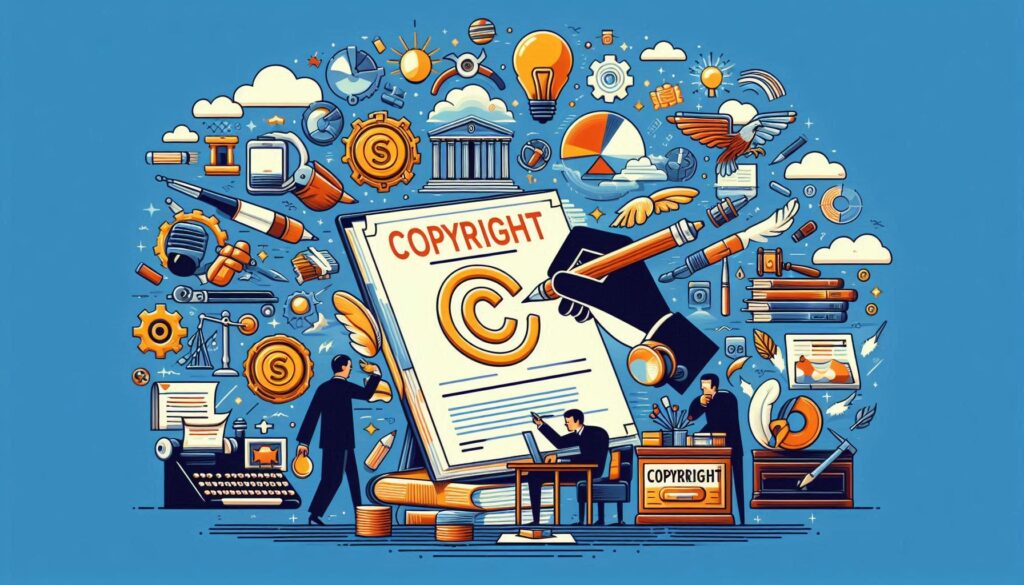
Copyright is a form of intellectual property protection that grants creators exclusive rights to their original works. It applies to a wide range of creative expressions, including literary works, music, art, software, and more. Copyright ensures that the creator has control over how their work is used, distributed, and monetized, while preventing unauthorized use by others.
Whether you’re an artist, author, musician, or business owner, understanding copyright is crucial to safeguarding your creative endeavors and intellectual assets.
Key Elements of Copyright
Copyright protection applies to original works that meet the following criteria:
- Originality: The work must be independently created and showcase a minimal degree of creativity.
- Fixed Form: The work must be fixed in a tangible medium of expression, such as written text, digital files, or recordings.
- Protected Categories: Copyright covers specific types of work, including:
- Literary works: Books, articles, essays, and poems.
- Musical works: Compositions, lyrics, and recordings.
- Artistic works: Paintings, drawings, sculptures, and photographs.
- Dramatic works: Plays and screenplays.
- Software: Computer programs and code.
Copyright does not protect ideas, facts, or concepts—it applies only to the specific expression of those ideas.
Importance of Copyright
Copyright serves as the foundation for protecting creative works and fostering innovation. Its significance lies in several key areas:
1. Exclusive Rights
Copyright grants creators exclusive rights over their works, including the rights to:
- Reproduce the work.
- Distribute copies to the public.
- Perform or display the work publicly.
- Create derivative works based on the original.
2. Incentive for Creativity
By ensuring creators can benefit financially and reputationally from their work, copyright encourages innovation and cultural development.
3. Legal Protection
Copyright provides a legal framework to address unauthorized use, ensuring creators can enforce their rights through courts or arbitration if necessary.
4. Economic Value
Creative works protected by copyright often represent significant economic assets. They can be licensed, sold, or leveraged for business growth.
Copyright Registration
While copyright protection is automatic upon the creation of an eligible work, registering a copyright provides additional legal benefits and strengthens your rights.
Benefits of Registration
- Legal Evidence: Registration creates a public record of ownership, making it easier to prove authorship in disputes.
- Enforcement: Only registered copyrights can be enforced in court.
- Monetary Damages: Registration allows creators to claim statutory damages and attorney fees in infringement cases.
Duration of Copyright Protection
The length of copyright protection depends on the type of work and jurisdiction. In general:
- For individual creators, copyright lasts for the creator’s lifetime plus 70 years.
- For works created by corporations or anonymous authors, the duration is typically 95 years from publication or 120 years from creation, whichever is shorter.
After this period, the work enters the public domain, where it can be used freely by anyone.
Infringement and Fair Use
What Constitutes Copyright Infringement?
Copyright infringement occurs when someone uses a copyrighted work without permission in a way that violates the owner’s exclusive rights. Examples include:
- Copying or distributing the work without authorization.
- Creating derivative works without consent.
- Publicly displaying or performing the work without proper licensing.
Understanding Fair Use
Fair use is a legal doctrine that permits limited use of copyrighted material without the owner’s permission, under specific circumstances. Common examples include:
- Educational use.
- Commentary, criticism, or parody.
- News reporting.
Courts evaluate fair use based on factors such as the purpose of use, the nature of the work, the amount used, and the effect on the market value of the original work.
How to Protect Your Copyright
- Document Your Work: Keep records of your creation process, including drafts, files, and timestamps.
- Include Copyright Notices: Adding a copyright notice (e.g., “© [Year] [Your Name/Business]”) deters unauthorized use.
- Register Your Copyright: Formal registration strengthens your rights and provides legal advantages.
- Monitor Usage: Regularly check for unauthorized use of your work online and offline.
Copyright vs. Other Forms of Intellectual Property
Copyright is one of several forms of intellectual property protection, each serving a unique purpose:
- Trademarks: Protect brand identifiers like logos and names.
- Patents: Protect inventions and technological innovations.
- Trade Secrets: Protect confidential business information, such as formulas or processes.
Understanding the distinctions between these protections is essential for managing intellectual property effectively.
Common Copyright Misconceptions
Myth 1: “If It’s Online, It’s Free to Use.”
Reality: Most online content is copyrighted, even if it does not display a copyright notice.
Myth 2: “Copyright Protection Requires Registration.”
Reality: Copyright protection is automatic upon creation of an eligible work, though registration strengthens enforcement rights.
Myth 3: “I Can Use Copyrighted Work If I Credit the Creator.”
Reality: Giving credit does not grant permission to use copyrighted material unless it falls under fair use or licensing agreements.
The Role of Copyright in Creativity and Commerce
Copyright is essential for fostering creativity, innovation, and economic growth. It:
- Empowers creators to control how their work is used and shared.
- Encourages the production of original works by ensuring creators can reap the rewards of their efforts.
- Protects the cultural and economic value of creative industries.
FAQs About Copyright
1. How Do I Know if My Work is Copyrighted?
Your work is automatically copyrighted if it is original and fixed in a tangible form.
2. Can I Copyright an Idea?
No, copyright protects the expression of ideas, not the ideas themselves.
3. Can Copyright Be Transferred?
Yes, copyrights can be transferred, sold, or licensed to another party.
4. What is the Public Domain?
The public domain includes works no longer protected by copyright, allowing anyone to use them freely.
5. What Should I Do If My Copyright is Infringed?
You can issue a cease-and-desist letter, negotiate a settlement, or pursue legal action to enforce your rights.
